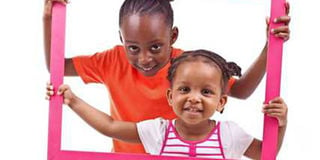The risks of sharing your child’s photos on the Net

More than 200 new images of underage children are circulated daily, and the production and distribution of child pornographic images rakes in between Sh300 billion and over Sh2 trillion per year worldwide. PHOTO | FOTOSEARCH
What you need to know:
Once an image is on the internet, you lose control over it
It could be lifted and reposted on a paedophile photo-sharing gallery
As gatekeepers of their children’s personal information, the onus is on parents to decide what should be kept private, and what may be shared with the outside world.
If you are an avid social media user, you will have noticed that many Kenyan parents — you could be one — post their children’s photos regularly, sometimes daily, on social networking platforms. especially Facebook. This (over) sharing photos, news, and videos of children on social media is known as sharenting.
Parents who are active users of social media and digital technology, share their children’s mileston’s online, from the ultrasound photos to their teenage children’s antics.
'TEAM MAFISI'
As gatekeepers of their children’s personal information, the onus is on parents to decide what should be kept private, and what may be shared with the outside world. Sharing a few photos on social media seems fairly harmless, but a conflict exists, nevertheless. Even if you choose to share them in private groups, how sure are you that someone will not screenshot, repost or share that picture of your adorable child? Worse still, once the picture is on the internet, you lose control over the narrative that will be formed around it as Nairobi County Women Representative Esther Passaris learnt in 2018 after posting a well-meaning birthday tribute to her 22-year-old daughter on Twitter.
Some of the responses left a bad taste in the mouth. For instance, Moreno KimChung (@MKimchung) wrote: “Tell us about her virginity …” while Muchiri wa Njoroge (@MuchiriNjoro) wrote: “Thanks so much for bringing up such a beautiful woman. We Team Mafisi will take good care of her.”
Ms Passaris was appalled, and immediately told off the two, but the damage had already been done.
According to statisticbrain.com, as of the first quarter of 2019, Facebook had 2.38 billion monthly active users worldwide. And there are an estimated 81 million fake Facebook profiles.
A United Nations report says that at any given time, there are about 750,000 sexual predators prowling the internet seeking to contact children. More than 200 new images of underage children are circulated daily, and the production and distribution of child pornographic images rakes in between Sh300 billion and over Sh2 trillion per year worldwide.
PAEDOPHILES
Kenya isn’t immune to this sinister reach. Every now and then, child trafficking and pornography cases are reported in the media, with the Coast region leading.
Unicef estimates that there are more than four million websites worldwide featuring minors, some below the age of two. Images of sexually exploited children are not only growing in number, but also increasingly shocking, with the UN putting the number of affected minors at between 10,000 and 100,000.
In 2017, the head of Canada’s national tip line for online child pornography warned citizens about paedophiles reposting seemingly innocent photos of children lifted from their parents’ social accounts and implanting them on child sexual abuse imagery sites, paedophile photo-sharing galleries and highly sexualised “child modelling” sites. Yes, innocent images of a child eating ice cream, playing in a pool or participating in sports are at any given moment, even now, being manipulated and Photoshopped to these sites.
The fact is that nothing online is ever completely private, and everything you post is permanent once posted, even after you delete it. The biggest concern after paedophilia is cyber bullying, when a child, preteen or teen is tormented, threatened, humiliated or otherwise targeted by another child, through the internet. Obviously, you might be setting your children up for a fight they did not choose by sharenting.
CONSEQUENCES
In the West, consequences of sharenting have been felt and it could only be a matter of time before our own "social media babies" follow suit, backed by the law.
In 2016, a from Austria ignited the sharenting debate after an 18-year-old woman from Carinthia sued her parents for posting 500 images of her on Facebook without her consent.
And last year, a 16-year-old Italian boy won a historic case against his estranged mother for constantly posting photos of him on Facebook without his consent. He argued that his mother’s actions had such a serious impact on his social life that he was considering transferring to a high school in the United States to make a fresh start. His mother was ordered to delete all references of him from her social media account by February 1, 2018, or risk a fine of approximately Sh1.2million. In both the UK and Italy, the subject of the photo owns the copyright, rather than the person who took the picture. In France, publishing and distributing images of another person without their consent can earn you a fine of over Sh5 million and up to a year in prison.




